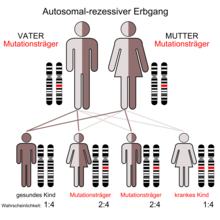recessive
Recessive (from the Latin recedere “step back, step back, step into the background”) means in genetics “stepping back” or “not appearing”. In genetics, a distinction is made between dominant (covering) and recessive (covering) alleles of a gene . A dominant allele prevails over a recessive allele in terms of characteristic expression. In order for a recessive allele to be characteristic, it must be homozygous or occur together with another recessive allele.
The recessive allele is mostly the result of a mutation and can lead to a trait with restricted functionality. If it is heterozygous , the non- defective ( wild-type ) allele can cover up the possible functional restriction and compensate for the deficiency of a defective allele. Recessive hereditary characteristics can be passed on by homozygous individuals but also by conductors .
There is also codominant and X-linked inheritance.
Examples
- If a person has the genetic make-up for blood group B on one of the parental chromosomes , and the allele for 0 on the homologous chromosome (from the other parent), he has blood group B, since the allele for 0 is recessive compared to the allele for B. Or the other way around: Because B is dominant, it prevails over the recessive 0 allele in the characteristic expression . Blood group A is also dominant over 0, which means that blood group 0 only occurs if there are 0 alleles on both chromosomes. A and B, on the other hand, are codominant : people who carry an A and a B allele show both blood group properties of A and B, which is why there is blood group AB.
- With the pea (Pisum sativum) there are plants with red flowers and others with white flowers. A gene with two different alleles is responsible for the flower color: one allele codes for red color, the other for white flower color. Since there are always two alleles in diploid organisms such as the pea plant that determine a characteristic, the plant can have two identical alleles for the red flower color, two identical alleles for the white flower color or two different alleles (one for the red and one for the white flower color ) own. The latter is what is known as heterozygosity , and in the case of the pea the plant bears red flowers because the red color encoded by one allele simply covers the white color of the other allele. Assuming that a pink flower is observed in the heterozygous plants under the same conditions, the corresponding inheritance is referred to as intermediate .
See also
literature
- Elisabeth Günther: Outline of Genetics , 2nd edition, Gustav Fischer, Stuttgart 1971
Individual evidence
- ↑ G. Czihak, H. Langer, H. Ziegler (Eds.) Biology. A textbook , 6th edition, Springer, Berlin 1996, p. 205
